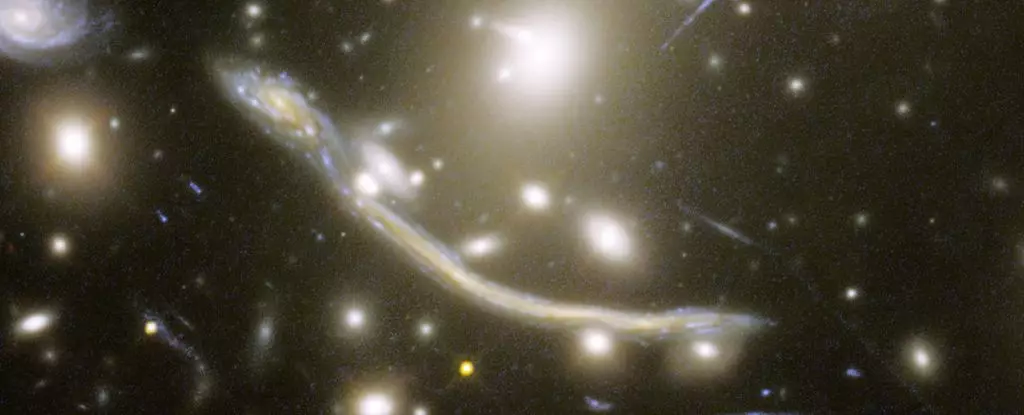The fabric of the cosmos has long captivated humanity, a vast expanse that acts as both a canvas and a puzzle. Our attempts to penetrate this cosmic shroud have invariably been met with limitations imposed by the vast distances and the subtle luminosities of ancient celestial bodies. However, recent advancements in astronomical technology, particularly the James Webb Space Telescope (JWST), have initiated a new chapter in our understanding of the universe, enabling us to peer into galaxies that formed billions of years ago.
The restrictions of conventional observational tools have historically hampered astronomers’ quests to study the early universe. For instance, the Hubble Space Telescope was limited to resolving only seven stars in some distant galaxies, primarily due to the blending of light from numerous sources, making it virtually impossible to discern individual stars. This limitation typically arose from the faintness and size of these distant stars, which were often lost in the immensity of space. The notion of fathoming the cosmos seemed grimmer as the focus was drawn primarily to the larger constituents, like entire galaxies.
Nevertheless, the JWST’s capabilities have dramatically altered this bleak landscape. By employing advanced optics and a design that allows for greater light collection efficiency, the JWST has enabled us to observe over 40 individual stars in a galaxy whose light has traversed nearly 6.5 billion years to reach Earth. This achievement not only expands our observational reach but significantly enhances our comprehension of star formation and evolution in galaxies that are fundamental to the universe’s landscape.
One of the groundbreaking techniques facilitating this unprecedented exploration is gravitational lensing—a phenomenon dictated by Einstein’s general theory of relativity, where mass bends the fabric of space-time itself. Massive objects, such as galaxy clusters, warp space around them, allowing light from more distant objects to bend, multiply, and magnify as it passes through these warped regions.
In this context, astronomical features named the Dragon Arc emerge as a miraculous manifestation of gravitational lensing, shaped by a colossal cluster of galaxies known as Abell 370. Situated approximately four billion light-years away, the Dragon Arc appears as a serpentine contour illustrating a distant spiral galaxy. This warped view, while initially disordered, offers astronomers the unique opportunity to disentangle the various images, enabling them to reconstruct a clearer view of these distant celestial bodies.
Adding another layer of complexity to this cosmic narrative is the occurrence of microlensing. In the inter-galactic void of the Abell 370 cluster, rogue stars inadvertently contribute to the intricate dance of light distortion. A recent study led by astronomer Yoshinobu Fudamoto utilized microlensing to unravel the presence of 44 distinct stars within the Dragon Arc. Initially focused on identifying a background galaxy, the research team stumbled upon these previously obscured stars, marking a historic milestone in the exploration of the universe.
The serendipitous discovery of these stars reveals convenient insights into early stellar populations, illustrating the effective applications of microlensing in astronomical research. This new approach not only augments our existing frameworks but also serves as a template for future explorations into the intricate interplay between dark matter and stars obscured in the complex tapestry of the universe.
Among the treasures revealed through JWST’s groundbreaking observations are the red supergiants comprising the majority of the stars identified in the Dragon Arc. Red supergiants, characterized by their cooler and larger structures compared to their bluer contemporaries, illuminate the late evolutionary phases of stellar life cycles. Their form signifies a time when stars have exhausted their hydrogen fuel, puffing up and cooling down, offering vital clues about the life stages of stars and their role in the galactic ecosystem.
These revelations tell a story much broader than mere stellar existence; they indicate shifts in the cosmic clock, allowing us to bridge knowledge gaps about galaxies that flourished billions of years ago. As JWST continues its mission, astronomers anticipate discovering even more concealed stars and elucidating the dynamics of these ancient galaxies.
The JWST serves as an emissary of humanity’s eternal quest for knowledge, pulling back the veil of the cosmos to reveal ancient light and stars scarcely seen. By overcoming previous observational limitations and utilizing innovative techniques like gravitational lensing and microlensing, astronomers are embarking on an exhilarating voyage into cosmic history. Each discovery not only compounds our understanding of the universe’s tapestry but also foregrounds our innate curiosity and desire to explore realms beyond our own. As we advance into this new era of astronomical research, the expectation of unveiling the secrets of the universe has never been more promising.

Leave a Reply